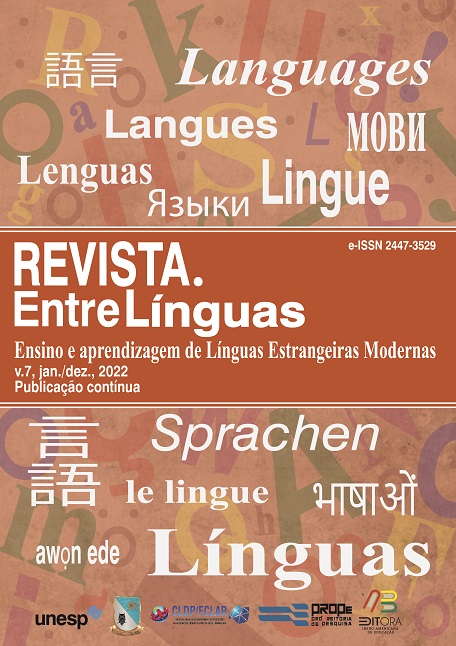Como a linguagem de comunicação comum foi abandonada no mundo turco?
DOI:
https://doi.org/10.29051/el.v8i00.17679Palavras-chave:
Rússia czarista, Repúblicas turcas, Alfabeto cirílicoResumo
As comunidades turcas que vivem em várias geografias do mundo desempenharam um papel importante em todos os períodos da história. Em meados do século 10, o estabelecimento do estado de Karakhanid e seu período islâmico iniciaram uma nova era para os turcos. Influenciados por essa civilização, usaram o alfabeto árabe até o primeiro quarto do século XIX. Os turcos russos do século 20 tiveram resultados ruins. De acordo com a "Política de Nacionalidades", os soviéticos dividiram a geografia na URSS. Stalin implementou a política da Rússia czarista para dissolver as comunidades turcas mais rapidamente e aboliu o alfabeto árabe usado pelos turcos com as decisões tomadas no Congresso Turco de Baku de 1926. Depois disso, em 1928, a Turquia mudou o alfabeto e ficou com o mesmo alfabeto. A unidade cultural entre os turcos seria revivida, mas Moscou hesitava. Sem perder tempo, a URSS trouxe o alfabeto cirílico e, finalmente, a nova geração cortou o contato com as outras.
Downloads
Referências
AGHAMALIOGHLU, S. Written Language and Culture of the East. Baku: VSK. NTA New Turkish Alphabet Soviet Central Committee, 1928. v. 1.
BABAYEV, A. The Open and Hidden Sides of the First Turkology Congress. Azerbaijan: University of Languages Publications, 2016.
BAKU TURKOLOGY CONGRESS. Ankara: Turkish Language Association Publications, 2008.
BAYRAMOVA, A. The New Beginning of the Science of Turkology in the XX Century: I. Baku Turkology Congress, Azerbaijan Journal of History and Methodology, v. 3, p. 12-15, 2016.
BURAN, A. Soviet Turkology and First Turkology Congress, Turkish Studies International Periodical for the Languages, Literature and History of Turkish or Turkic, v. 4/3, p. 23, 2009.
BURAN, A. Bulleted Turkology. Ankara: Akçağ Publications, 2010.
CHAQUERI, C. First Congress of Eastern Peoples. England: Cambridge University Press International Journal of Middle East Studies, v. 26, n. 4, p. 711, Nov. 1994.
DEMIREL, O. F. I. In: TURKOLOGY CONGRESS, Ankara, 1992. Proceedings […]. Ankara: Turkish Historical Society Publications, 1999.
DEVLET, N. Opening Speech of the International Symposium on Contemporary Turkish Alphabets. Istanbul: Marmara University Publications, n. 509, 1992.
FIRST TURCOLOGY CONGRESS. Report 26 February-5 March 1926,1. bs. Azerbaijan: Ministry of Culture and Tourism Publications, 1926
FIRST TURKOLOGY CONGRESS REPORT MINUTES. 26 February-5 March 1926. 1. ed. Azerbaijan: Ministry of Culture and Tourism Publications, 2011.
GALANTI, A. Arabic Letters Do Not Prevent Our Progress. Istanbul: Bedir Publishing House, 1996.
GASOMOVA, B. “Historical Development Process of the Azerbaijani Alphabet Azerbaijan Press in the Transition Process from the Arabic Alphabet to the Latin Alphabet (New Way, New Idea, Işık Yol)”. Turkish World Journal of Language and Literature, v. 51, p. 39-40, Spring, 2021.
HÜRREMKIZI, A. The Participation of Turkic Peoples and the Issue of Elifba in the Turkology Congress. Azerbaijan: National Academy of Sciences, 2016.
KAZIMOGHLU, M. The Invisible Side of the First Turkology Congress. Azerbaijan: National Academy of Sciences, 2016.
KHOJAYEV, K. S. My Old Memories and Emotions on New Elifba Ways. Baku: Manuscripts Department No: 496-362-81, 1929.
KILICH, R. Educational Issues in Turkey and Turkish Republics. Available: http://host.nigde.edu.tr/remzikilic/makale/index.php?entry=entry091114-201135. Access: 02 June 2020.
KOLTUK, N. Azerbaijan in Ottoman Documents. Istanbul: TDBB Publications, 2015.
NERIMANOGHLU, K. V. 1926 Baku Turkology Congress. Baku: Chinar, 2006.
NESIROVA, A. Latin Alphabet Stages in Azerbaijan. Azerbaijan: Ministry of Education Publications, 2019.
ORDBADY, M. S. Yeni Yol Newspaper, 07.12.1927. Azerbaijan Archive. Place No: 26452. p. 34. 1927.
OTTOMAN STATE ARCHIVE. Archive 30-18-1-1 / Department of Decisions (1920-1928) Location: 17-91-9.
POLIVANOV, E. D. “One of the Theorists of Soviet Language Policy A. Sh.Bikkulova”, Journal of Young Science, v.12, p. 219, 2011.
SARAY, M. Language and Culture Union in the Turkish World. Ankara: Turkish Language Association Publications. 2008.
SHERIFOGHLU, O. Defense of Islamic Letters. Istanbul: Sebil Publishing. 1997.
SHIMSHIR, B. N. History of Turkish Alphabet in Azerbaijan. Ankara: Turkish Historical Society Publications. 1991.
TACEMEN, A. Changing the Alphabets of the Turks under Russian Rule, (1769-1940). Kayseri: Erciyes University Publications, n. 68, 1994.
TOKER, M. Khalid Who Played a Major Role in Turkistan's Transition to the Latin Alphabet Seid Hodjayev and New Elifba Roads Old Memories and My Feelings. In: TURKOLOGY CONGRESS, Ankara, 1996. Proceedings […]. Ankara: Turkish Historical Society Publications, 1999.
TOYNBEE, A. J. The adoption of the Latin in place of the Arabic alphabet in Turkey and in the Turkish States Members. London: Oxford University Amen House, 1929.
TURKMEN, F. Common Alphabet Language Transition to Latin alphabet in Kazakhstan, Uzbekistan, Azerbaijan. New Turkey, v. 101, p. 318-319, May/June, 2018.
WHITE, S. Communism and the East: The Baku Congress, 1920. England: Cambridge University, 1974.
YENI YOL NEWSPAPER. Azerbaijan Manuscripts Department. Place No: 07 (49-924) J-56,1927.
YESILYURT, Z. Russification Policy in the Soviets and Murdered Intellectuals. Turkish Culture, v. 165, p. 562, 1976.
Downloads
Publicado
Como Citar
Edição
Seção
Licença

Este trabalho está licenciado sob uma licença Creative Commons Attribution-NonCommercial-ShareAlike 4.0 International License.
Os manuscritos aceitos e publicados são de propriedade da Revista EntreLínguas. Os artigos publicados e as referências citadas na Revista EntreLínguas são de inteira responsabilidade de seus autores.
Transferência de direitos autorais – autorização para publicação
Caso o artigo submetido seja aprovado para publicação, já fica acordado que o(s) autor(es) autoriza(m) a UNESP a reproduzi-lo e publicá-lo na EntreLínguas, entendendo-se os termos “reprodução” e “publicação” conforme definição respectivamente dos incisos VI e I do artigo 5° da Lei 9610/98. O artigo poderá ser acessado pela rede mundial de computadores (Internet), sendo permitidas, a título gratuito, a consulta e a reprodução de exemplar do artigo para uso próprio de quem a consulta, desde que haja a citação ao texto consultado. Essa autorização de publicação 328 EntreLínguas, Araraquara, v. 1, n .2, p. 323-328, jul./dez. 2015 não tem limitação de tempo, ficando a UNESP responsável pela manutenção da identificação do(s) autor(es) do artigo. Os artigos publicados e as referências citadas na Revista EntreLínguas são de inteira responsabilidade de seus autores.











